1850
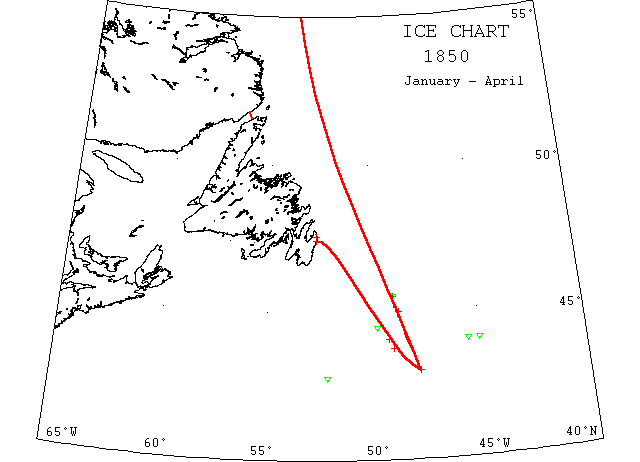
1850
No issues of the Newfoundlander available.
Jan 30 Ship “Havre” from Havre to New York ~44N 45W passed a large berg; 31st, 44N 4530’W saw several islands of ice to the SW at a distance of 7,9 and 12m. (SCL).
Mar 17-20 “Berlin” for Philadelphia saw several icebergs & large fields of ice. (LL).
Mar 23 Ship “John Revenel” [“Ravenel” – LL] from Liverpool to Philadelphia 4410’N 4830’W discerned a field of ice ahead, extending in a SSE and NNW direction, as far as the eye could reach. Seeing no opening to the westward, coasted the ice along to the southward, as far as 43N when they were enabled to keep the ship to the westward; 24th, discovered a barque fast in the ice. ‘JR’ sustained some damage to spars and sails. (SCL).
Mar 23 Packet ship “New York” from havre to New York in 45N 4845’W fell in with a strip of field ice extending from NNE to SSW from ½ – 1m in breadth, many places from 20′ to 30′ in length, and ~8′ thick; ran along the eastern edge ~40m, when we passed through it, as we could not see any termination either N or S. Supposed the strip to reach about 60m. (SCL).
Mar 24 Barque “Jane E. Williams” from Antwerp to New York on the eastern edge of the Banks, 4530’N saw several bergs, and to 44i45’N was one field of ice; was obliged to beat to the south 18 hours, with the wind from SSE to SW and was then obliged to run through it for about 1m. (SCL).
Mar 25 Ship “Cornelia” from Liverpool to New York 4345’N 49W fell in with large quantities of ice, extending in detached masses for several miles; fell in with it again on the 29th, and were compelled to steer south to clear it. (SCL).
Mar 27 Ship “Francis” from Antwerp to New York 4428’N 3947’W fell in with a number of icebergs. The ship struck one which injured the rudder and stripped off a quantity of copper. Same night passed through 2 large fields of ice. (SCL).
Mar~30 Ship “Wm. D.Sewall” from Liverpool to New York saw large quantities of field ice on the southern edge of the Grand Banks. SCL
Apr 10 “Fanny” lost at the seal fishery. (#511).
Apr 10 “Great Britain” fell in with large quantities of very heavy ice between St. Paul’s and Anticosti, coasted along the edge of it 250m, then took it, and passed through 85m, got clear on the 14th, the South Point of Anticosti bearing NNE 10m. (LL).
Apr 14 Ship “Leibnitz” from Hamburg to New York 4245’N 5210’W saw about 100 icebergs, some of them very large. (SCL).
Apr 23 Steam packet [“Falcon” ?] from Halifax unable to get in because of large quantity of ice which still blockades our harbour. Put into Bay Bulls where a number of other vessels are waiting. (RG).
Apr 24 “Emerald” lost at the seal fishery. (#511).
Apr 25 St. John’s: The coast has been blocked with ice for nearly 3 weeks; there is now every prospect of the navigation being open. (LL).
Apr 26 Issue: The RMS “Falcon” was signalled from the Hill on Monday last (Apr 21), but owing to the obstruction encountered off Petty Harbour, from the heavy ice with which the coast has been beset, she did not reach her destination until Tuesday night. (PL).
Apr 28 SS “City of Glasgow” from Glasgow to New York met field ice [no pos.] and was obliged to run south, a detention of about 14 hours. (SCL).
Apr 30 “John” lost at the seal fishery. (#511)
May 3 Issue: SS “British Queen” for Halifax from Hamburgh arrived Apr 30, after hectic trip but no mention of ice. (PL).
May 4 The “Evergreen” for Quebec made the ice on the Grand Banks in 47N, was beset in a solid field and remained 12 hours; she received damage to her sheathing and makes some water. (LL).
May 10 Issue: RMS “Falcon” put into Bay Bulls May 8, prevented from reaching her destination by the ice which had been pressed upon the shore by the late north easterly winds. (PL).
May 10 Ship “Hibernia” of Glasgow was sunk by ice on the Banks of Newfoundland. (SCL).
May 10 Barque “Clyde” from Glasgow bound to Montreal, out 29 days was in Trinity Bay endeavouring to get to the southward between the ice and the land, all well. (LL).
May 12 “Margaret Anne” lost at Pickford Is. (#511).
May 12 The schooner “Ann Semple” from Liverpool to St. John’s struck against an iceberg and immediately foundered, 50m east of St. John’s. Crew picked up by the “Maria Grace”. (PL).
May 13 The “Acorn”, of London, from Liverpool to St. John’s, foundered in the ice, crew picked up by the “Blessing”. (PL).
May 13 “Haberdine” from Teignmouth to St. John’s, hull damaged and part of her cargo thrown overboard in gale and in the ice. (LL).
May 15 “Collector” from Boston to St. John’s had her side stove in by ice off Cape Race. (LL).
May 15 Steamer “Falcon” at Halifax from St. John’s reports vast quantities of ice going down; had to put into Cape Bayle [sic] and the Bay of Bulls. (SCL). May 18 Barque “Ann” of Plymouth was sunk off the Magdalens, another in the Gulf. (SCL).
May 18 Issue: “Mary” from Newfoundland arrived at Bristol, reports having passed through nearly 150m of field ice on the Banks of Newfoundland, about 46N. (LL).
May 20 Ice off Scatterie, a vessel fast. (SCL).
May 22 New York: “Wilhelmina” of Aberdeen has been lost in the ice, crew picked up by the “Favourite”, arrived at Quebec. (LL).
May~25 Quebec: Various reports of vessels going down in the ice off St. Paul’s Is., Magdalens and in the gulf. (LL).
1851
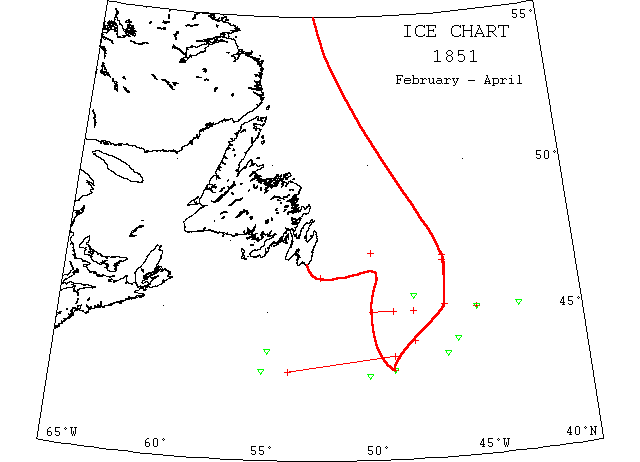
1851
“The year 1851 was remarkable for the quantity of ice that was seen, and its early appearance. It was seen early in January, on the NE edge of the Banks, and in April it was seen from 48N 43W to 43N 56W. The writer of this note, on board the steamer Humboldt, Capt.Lines, on 11th May, 1851, saw the ice in 46N 49W, and passed more than 50 icebergs, from 15 to 150′ high, leaving it in 4630’N 47W. The ice had an ENE and WSW direction. On the return passage, June 14, the same steamer fell in with ice in 4636’N 49W; two icebergs only.” (GWB in WCR).
Feb 1 The “Zebulun” arrived St. John’s from Cadiz, fell in with heavy ice 70m to the eastward of the Banks. (PL?).
Feb 2 SS “Asia” from New York to Liverpool fell in with a large body of field ice in 45N 50W at 8 pm and proceeded at ½ speed but got clear of it next day at 3 am. (SCL).
Feb 3 Liverpool: SS “Pacific” from New York, sailed Jan 22 for Liverpool encountered very severe gales from NW between the Banks and Cape Clear, and was in the ice ~30 hours. (LL).
Feb 4 Issue: There is reason to think that a considerable quantity of ice has been upon the coast for some time past, slowly floating down from the northward, which would account for the remarkable severity of the weather which has been experienced, and the long continuance of it. (PL).
Feb 10 The “Bideford”, from Cadiz for Newfoundland, has put back here (from Willmer & Smith’s European Times) – bore up from 52W, with loss of sails, and injured by ice. (PL).
Feb 11 (from Halifax Feb 3): Mail Steamer “Canada” arrived, detained more than 2 days in the ice. (RG).
Feb 13 Issue: The winter, up to the present week [now mild] has been of many degrees the most severe of which we have any recollection [but few mentions of ice]. (Newf.).
Feb 14 The “Gypsy”, from Greenock to St. John’s, 35m SE of Cape Race in the ice, was supplied with provisions from the “Norval”. (later arrived St. John’s Feb 21) (PL).
Feb 17 Ship “William Tell” from Havre to New York met large quantities of field ice in 4651’N 4630’W and finding it closed up was obliged to run south 100m before she could round it’s southern point. (SCL).
Feb 18 “Niagara” for Liverpool was in a field of soft cake ice in 45N 48W and was 20 hours passing through it with a fair wind. The ice was 18″ thick; saw 18 icebergs besides. (LL).
Feb 20 Ship “Hendrik Hudson” from London to New York 4640’N 4630’W fell in with large quantities of ice and icebergs; was 12 hours in the ice. (SCL).
Mar 1 Brig “Gypsey” from Greenock for Newfoundland fell in with a great quantity of ice 15m to the west of her destined port (?). On the 14th, finding ice too heavy, returned to Greenock (from Greenock Advertiser). (PL).
Mar 4 “Harmony” from St. John, NB at Liverpool was beset in the ice on the Grand Banks for 3 days and lost martingale, sprit sail yard, etc. (LL).
Mar 8 Ship “Forest King” from Liverpool to New York 4530’N 48W saw 18 large icebergs and on the 11th fell in with large quantities of field ice extending 120m, had to stand southward for 2 days to get clear of it. (SCL).
Mar 9 The “Witch” from Calcutta to Liverpool [last pos. Feb 28, 39N 39W] saw a large water spout formed of congealed ice which broke close to the ship and completely deluged her with small particles of ice. (SCL).
Mar 12 Issue: Ship “Isaac Wright” at New York from Liverpool reports – 45N 45W saw a great number of icebergs and a large extent of field ice. The ship was surrounded with it for 12 hours and got very much cut by ice around the bows. (SCL).
Mar 21-25 Barque “Jennett” from London to New York in 43-4330’N and 49-54W saw extensive fields of ice and icebergs some 200′-300′ high – was at one time blockaded by ice and nothing could be seen but vast fields studded with icebergs – was 12 hours in one field, the men getting upon the ice and working the cakes from each bow. (SCL).
Mar 22-23 Barque “Dorothea Henrietta” from Rotterdam to New York 44N 48W saw several icebergs and large quantities of field ice as far as the eye could extend. (SCL).
Mar 22-23 SS “City of Glasgow” 43N 49W passed through loose ice for 3 hours; 23rd, 44N 46W passed several bergs. (LL).
Mar 23 “Barbados” from Smyrna to Boston passed several large fields of ice, one apparently aground in 50 fathoms in 43N 49W. (LL).
Mar 23 Ship “Manhattan” from Liverpool to New York 45N 45W saw several large icebergs and next day fell in with large quantities of field ice and was 4 hours passing through it. (SCL).
Mar 28 Dublin: “Elizabeth” arrived at Kingstown from St. John, NB, passed a great many icebergs between 57W and 47W. (LL).
Apr 7 4330’N 4630’W bergs. (WCR).
Apr 10
Apr 13 43N 5515’W bergs; 17th, 4340’N 55W bergs. (WCR).
Apr 20 Report from brig “Renovation” regarding possible sighting of Sit John Franklin’s ship the HMS “Terror” and “Erebus” in the ice in 20 April 1851 near the east edge of the Bank in 4530’N [M11 quotes same position] in icebergs with field ice attached. Another position at 30m east of Cape Race. (from PL 7 May 1852) (PL). Apr 23 One of the most remarkable facts.. 2 deserted ships were seen high and dry upon a floating mass of ice on Apr 23 by the “Renovation” in about 47N 50W. Were thought originally to be the “Erebus” and the “Terror” but still remains a mystery (from British American Sailing Directions 1862 [see 1859 entry]). (#837).
Apr 24 Ship “Rejah” from Liverpool to New York 4250’N 5010’W saw a large island of ice. (SCL).
May 4 Schooner “Totness” of Dartmouth from Plymouth for Labrador struck a pan of ice in 53N, 46W which stove in larboard bow, and foundered. Crew landed on pans of ice and rescued by sealer “British Queen” and carried into Greenspond. (PL).
May 9-11 The “North America” from Hamburg to New York 45N 46W on the eastern edge of the Banks passed a great number of icebergs, most of them aground. (SCL).
May 23-25 “Carlo Mauran” between 44N and 45N and 49-54W [fell in with] large quantities of ice. on 25th, carried away foremasthead, maintopgallantarm etc. – SCL.
May 29 Halifax: “Lady Elgin” from Lisbon to Quebec got into St. George’s Bay previous to May 12 after being 14 days in the ice; ship tight; and reports 40 sail in company with her in the gulf, and believes many to have suffered severely, if not in many instances total losses. (LL).
Jun 27 SS “Washington” from New York to Southampton passed 10 very large icebergs between longs 50 – 45W in 47N. (M11).
Jul 17 4420’N 4730’W bergs. (WCR).
— — Captn(?) Nye 45N 47W bergs. (WCR).
Sailing sealer “R.M.C.” lost at seal fishery. (NW).
1852
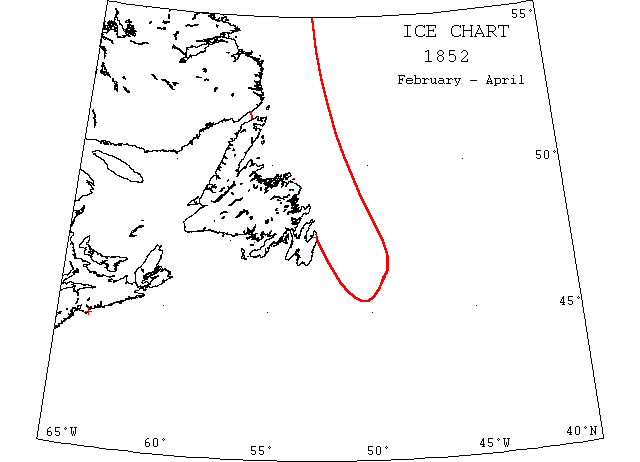
1852
40 vessels crushed in the ice near Wadham Is. (SE of Fogo Is.). (JEC).
This was “The Spring of the Wadhams” occurring in early April in a NE storm. In February ice surrounded the Funks. (JF).
From entries from journal of Robert William Dyer of Greenspond in NW:
Apr 5, a great many vessels coming around the Cape (Freels), some of which are in great danger of being wrecked, a great sea coming in. Apr 6, it is reported at 25 or 27 vessels are abandoned, 11 of which can be seen from the hill above our school, and many of which appear totally wrecked. Apr 15, men have been coming continually every day. Some difficulty in placing them in houses. We have now in Greenspond nearly 1,200 men. Apr 19 & 20, 400 men left Greenspond in 2 vessels. Apr 22, a large vessel arrived from St. John’s with provisions for the distressed. A second vessel from St. John’s arrived later in the day. Because of ice conditions, the 2 vessels, the “Houlahand” and the “lady of the Lake”, were unable to leave until the 29th, when they took nearly 300 men, the last of the shipwrecked sealers. (NW).
Feb 2 Halifax: “Responsible” from Boston to PEI had been driven ashore by ice at Plaister Cove; crew and cargo saved. (LL).
Feb 23 Mention of ice around Funk Islands. (PL).
Mar 28 Vessels detained outside (St. John’s) by the Ice, being close in shore (arrived a couple of days later). (PL).
Apr “On the 22nd [April] reports state that Halifax harbour was completely blocked by heavy Gulf ice. 6 steamers and 50 sail vessels were detained in port on account of ice. No such blockade has occurred in the past 42 years. [from April 1894 issue of MWR].
Apr 3 Issue: A number of vessels recently arrived report having seen large quantities of field ice on the Grand Banks. (SCL).
Apr 5 Trinity Bay full of ice (since about Feb. 23). (PL).
Apr 8 Last Monday’s (5th) gale of wind – lost “Henrietta” and “Mary”. (Newf.).
Apr 9 Two vessels supposed to be the “Ottawa” and the “Montreal” seen in the ice in the Gulf of St. Lawrence. (LL).
Apr 13 Schooner “Elizabeth” wrecked at the Wadhams (presumably ice around). (PL).
Apr 15 Fearful disaster in the gale of Monday last (12th ?) lost “Western Trader”, “Ajax”, “Vesta”, “Elizabeth”, “Placid”, “Christianna”. The crew of the “Helen” came in from Bay Bulls. Also, (from a letter from Bonavista Apr 5) Trinity Bay full of ice. (Newf.).
Apr 16 Issue: mention of spring gales causing numerous ship and live losses. One of the worst in the island’s history. (PL).
Apr 20 Issue: The following vessels reported as lost during the late violent storms: “Henrietta”, “Mary”, “Helen”, “Daniel O’Connell”, “Speedwell” and 7 others. About 1000 shipwrecked sealers in Greenspond. (RG).
Apr 23 Accounts from St. John’s at Halifax report that between 50 and 60 sealing vessels were wrecked in the ice in the gale of Apr 20 and some lives were lost, but no particulars are given and the report is probably exaggerated. Hundreds of sealers are said to have reached Richard Island, Bonavista Bay who were in a state of destitution and want. (SCL).
Apr 23 St. John’s: Most disastrous intelligence has reached this place from the ice. 55 to 60 sealing vessels are reported to have been totally lost or abandoned between Fogo and Greenspond during the present month in gales at ENE on the 5th and 12th April. About 90 lives are said to be lost. The “Maria Grace” was totally lost in the ice off Cape Freels, Apr 22. [Then follows a list, May 10 issue, of 42 vessels lost at the Wadhams and Cape Freels 12th and 13th April, and a further 10 abandoned and later taken as prizes. May 11 issue lists another 8 vessels lost, dated St. John’s Apr 8-10th, and 3 others brought into Conception Bay derelict]. (LL).
May 4 Issue: If not for losses, one of the best fisheries ever. (RG).
May 7 Issue: Report from brig “Renovation” regarding possible sighting of Sit John Franklin’s ship the HMS “Terror” and “Erebus” in the ice in 20 April 1851 near the east edge of the Bank in 4530’N in icebergs with field ice attached. Another position at 30m east of Cape Race. ( PL).
Lost at the seal fishery, no date: “Cornelia”, “Philanthropy”, “Hope”, “Fortitude”, “Britannia”, “Liberator”, “Eliza”, “David O’Connell”, and “Sally”. (#511).
May 22 Issue: Strait of Canso full of ice. (SCL).
Jun 7 SS “Washington” at Bremershaven between 46N and 48N and 50W and 46W passed a considerable number of large bergs. (LL).
1853
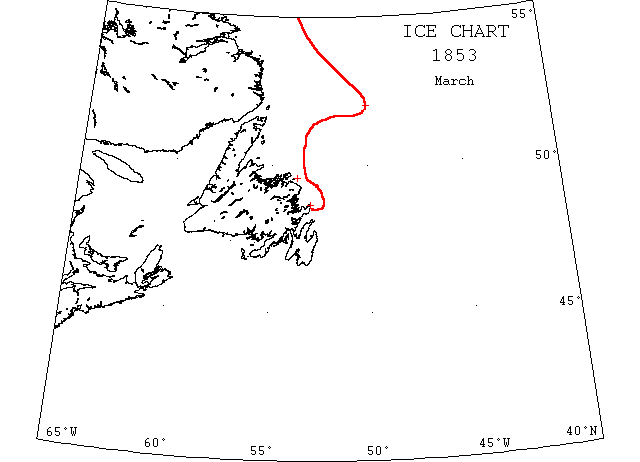
1853
Mission ship “Harmony” met little ice off Labrador to impede her progress. (EW).
No mention of ice in RG.
No mention of ice in SCL, though several storm incidents on the Banks .
No mention of ice off Newfoundland in LL.
Feb 28 We have no recollection of a season of such mild weather as at present. February has now gone and left neither frost or snow behind it. Temperatures like April and May. (Newf.).
Mar 7 (Brig “Clutha” from Cadiz to Harbour Grace lost at Western Bay Point). (PL).
Mar 21 (from Harbour Grace Mar 18): Reports of vessels off Cape Bonavista supposed to be taking seals as they are in the ice. (Newf.).
Mar 28 “Britain”, Captn. H. Forwaid (?) arrived at C— no seals. It is stated that (he?) left some 30 of her crew on Pinchard’s Island where they were driven by slob and in danger of being wrecked. Whole crew had abandoned vessel but 9 or 10 returned when she got clear of the rocks, others having missed the opportunity. Captn. F. saw plenty of ice and thinks well of prospects. Some foreign arrivals at H.J(?) report ice and seals 200m NE of Funks. (#511).
Mar 31 (from the Post Mar 29): The Briton, Forward master, arrived from the ice last night, no seals. She was driven in amongst the Wadham Islands in the ice and slob on Mar 11, men all left her, after which she drove clear, then the master and 10 of her crew again boarded her, all the others refusing to do so. She drove 80m in ice when she got clear and put into Seldom-come-by and having there heard of his men, bore up for home. (Newf.).
Apr 1 Issue: promising seal fishery. (PL).
1854
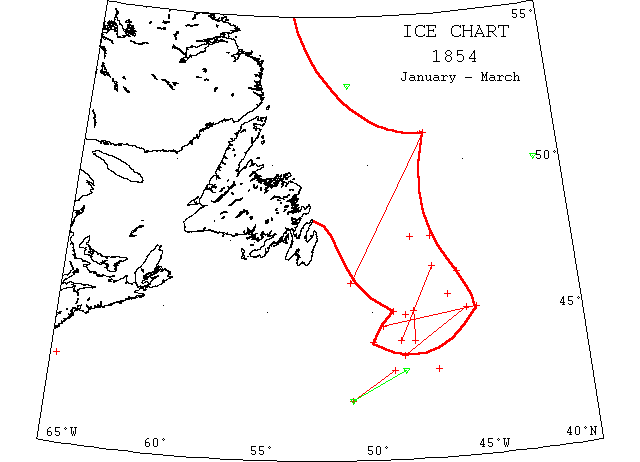
1854
The winters of 1853-54 … .. were confessedly severe in the extreme (from Sailing Directions for the Island of Newfoundland 1873). (#837).
No mention of ice in RG.
“Cabot” lost at seal fishery. (#511).
“The year 1854 was also remarkable for the early appearance and great extent of the ice. It was seen in February, by Capt. Delano, ship “Albert Gallatin”, in 58N 43W, and from that time to the present it was fallen in with as far south as 4246’N and 52W. June 18, immense quantities were seen from the steamer “Union” in 4354’N 4820’W.” ( 1 July 1854 GWB in WCR).
Jan 31 from Halifax: vessel locked in by ice 43N 6442’W. (SCL).
Feb 3 Non-arrival of the “Arabella Tarbet”. 2nd ship crew lost within a year. (#866).
Feb 14 Ice of Barrington harbour [NS ?] wrecking a ship. (LL).
Feb 15 The barque “Mary” of Yarmouth, N.S. sailed from Liverpool 3 Jan. for Boston, experienced heavy weather and in 4730’N 48W [47N 43W – LL] fell in with the Ice which stove in the bow timber port. Went down in 20 minutes, the crew taking to the long boat. In the boat for 5 days before being picked up by the brig “Caroline Schenk” On Feb 20. (PL).
Feb 16 SS “Canada” at Halifax passed through considerable quantities of ice and lost several paddle floats. (LL).
Feb 23 St. John’s: There is a heavy drift of ice on the coast and vessels find much difficulty in their way through it. (LL).
Mar – early Ship “Richard Alsop” from Liverpool to Alexandria 43N 47W fell in with large quantities of ice. (SCL).
Mar 2 We hazard no conjecture as to the prospects of the [sealing] voyage but the excessive frosts experienced so frequently up to this time forbid us to expect what is termed an open spring. (also report on the barque “Mary”) (Newf.).
Mar 3 Issue: winter so far unusually severe. (PL).
Mar 9 Ship “Wm. Nelson” from Havre to New York 43N 49W came suddenly on a field of ice 4′ to 8′ thick, wore immediately to SE was 20 minutes in getting clear during which time knocked off 16′ of lower cutwater, bruised stem, started the wood, etc. (SCL).
Mar 9-11 SS “Baltic” at Liverpool from New York ran into an opening in an immense pack of ice, filled with bergs, in a fog, in 4630’N 47W and owing to the fog was unable to find a way out till noon on the 11th in 44N 4840’W having run a distance of more than 300m to the SSW, between a great number of icebergs and large patches of field ice, and damaged the paddles. (LL).
Mar 10 Ship “Sir Robert Peel” from Liverpool to New York 4454’N 4825’W saw an immense number of large icebergs and a great quantity of field ice. (SCL).
Mar 10 SS “Sarah Sands” from Portland to Liverpool 45N 48W saw field ice and hauled to the south along its edge and 5½ hours later rounded the south side and saw many bergs. (LL).
Mar 11 Issue: Ship “Middlesex” at New York [7th – LL] from Liverpool was 5 days in the ice from 51N 47W to 46N 51W [46N 47W to 46N 51W – LL] which carried away false stem and part of the main stem; was compelled to spike some boiler iron on the bow to prevent the ship from being cut through. Passed through ~300m of field ice, counted 30 icebergs at one time. (SCL).
Mar 12 Ship “American Union” at New York from Liverpool to New York sailed between and passed during the day about 73 very large islands of ice, besides numerous small ones covering a large surface, but laying so near the edge that they were not perceivable until very near them [?]; was amongst them on the evening of Apr 2.(SCL).
Mar 14 Issue: St. John’s sealing vessels, with strong westerly winds, were able to get through the ice in the harbour and out through the Narrows. (PL).
Mar 15 SS “Europa” from New York to Liverpool 45N 49W fell in with large fields of ice but cleared it in 2 hours. (LL).
Mar>16 Ship “Harriet & Jesse” from Havre to New York from 42N to 43N and 49-51W saw a large number of icebergs and fields of ice. (SCL).
Mar 19 Ship “Arctic” [9th, in LL, arrived Apr 6] from Liverpool to New York 4530’N 4620’W in a thick fog, ran into a large quantity of field ice, and lost 18′ of the cutwater; was 6 days in getting clear of the ice, with string gales from the S to SW. (SCL).
Mar 19 SS “Nashville” to Cowes 44N 48W several bergs and great quantities of field ice. (LL).
Mar 20-21 Ship “Guy Mannering” from Liverpool to New York 45N to 4330’N and 4530’W to 4830’W fell in with a large number of icebergs and much field ice; some of the bergs from 90′ to 100′ high. (SCL).
Mar<21 Issue (from Kinsale Mar 21): Just arrived SS “Sarah Sands” from Portland to Liverpool 43N 48W met several large icebergs, some of them 70′ high, which is very unusual at so early a period of the season. (SCL).
Mar 21-22 Ship “Senator” from Liverpool to New York from 43N to 42N and 4830’W to 51W saw several icebergs. (SCL).
Mar 22 Ship “Henry Clay” from Liverpool to New York passed a ship in 5056’N 26W passed large quantities of ice from 4430’N to 45N and 45W to 4930’W was surrounded with icebergs large and small. (SCL). Mar 22 The “Kossuth” from New York to Liverpool got into the ice 44N and did not get clear till next day. (SCL).
Mar 26 Ship “Ocean Queen” 4120’N 46W ran among large masses of ice; was 2 days before getting clear of it, saw it as far south as 44N. (SCL).
Mar 26 Barque “Elizabeth” from Messina to New York 4615’N 4550’W saw a great quantity of ice; was surrounded by ice for 5 days, some of which were islands of 150′ in height and 2m in length. (SCL).
Mar 27 Ship “Hibernia” 49(?)50’N 4120’W fell in with several large icebergs, obliged to run under easy sail with easterly winds for 3 days during which time passed immense quantities of ice and large icebergs. In 5240’N 51W saw a number of large islands. (SCL).
Mar 28 St. John’s: A good deal of drift ice has passed to the southward during the last month very near the land, at present it is some distance off, and vessels can approach any harbour from Bacalieu south. (LL).
Mar 29 SS “Arctic” arrived Liverpool from New York encountered a large field of ice in which she was detained nearly a day, damaged. (LL).
Mar 29 SS “Ottawa” at Liverpool from Portland 44N 50W passed several bergs and a quantity of loose ice. (LL).
Mar 29-31 Ship “Yorkshire” from Liverpool to New York 4730’N 47W fell in with innumerable icebergs and field ice for 4 days; the ship continued ice-bound 30 hours and in endeavouring to get clear carried cutwater away. (SCL).
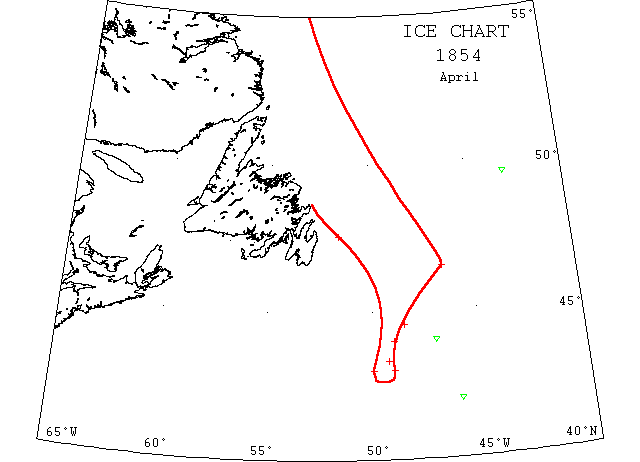
1854
Apr 1 Issue: SS “Franklin” at New York from Havre 4630’N to 4433’N and 4630’N to 4830’W met with large quantities of field ice and several icebergs and was obliged to steer south for several hours. (SCL).
Apr 2 “Briton” lost at seal fishery. (#511).
Apr 5 Issue: Ship “Albert Gallatin” at New York from Liverpool fell in with large quantities of field ice and was compelled to stand SE and passed S of the Banks. (SCL).
Apr 5 “Tuscarara” at Philadelphia was 4 days among the ice and received considerable damage. (SMG).
Apr 8 Issue: Brig “Pinnasberg” at New York from Rotterdam reports having been 4 days amongst the ice receiving considerable damage. (SCL).
Apr 8 Issue: Ship “Albert Gallatin” [see Apr 5 and opening paras] 4930’N 43W saw a number of icebergs, altogether about 40 and continued seeing them till on the eastern edge of the Banks when in 44N 49W fell in with immense masses of field ice and was compelled to stand to the SE and pass S of the Banks to get clear of it. (SCL).
Apr 8 Issue: Ship “Star of the West” at New York from Liverpool 4320’N 4915’W saw large quantities of field ice; passed close to several bergs from 10′ to 20′ above the water. ( SCL).
Apr 8 from New York: Barque “Mary” has been totally lost in the ice. (SMG).
Apr 8 from New York: Ship “Conqueror” from Liverpool saw large quantities of ice on the Banks. (SMG).
Apr 12 Brig “Elise & Charlotte” from Bremen to New York 4259’N 3844’W in a fog ran foul of an iceberg which stove in the stem, carrying away bulwarks, rails, etc. (SCL).
Apr 12 Issue: Ship “St. Dennis”, a storm Mar 11 in 48N 38W and after encountered large quantities of ice which carried away lower part of cutwater. (SCL).
Apr 12 Issue: Ship “Washington” at New York from Liverpool saw large quantities of ice on the Banks. (SCL).
Apr 12 Issue: Ship “Garrick” at New York from Liverpool saw to the eastward of and on the Grand Banks several icebergs, some of which were as far south as 43N. (SCL).
Apr 14 SS “Pacific” at Liverpool from new York on the Banks in 43N passed a number of bergs. (LL).
Apr 19 “Lady Falkland” from Apalachicola to Liverpool 42N 46W ran foul of a berg with loss of bowsprit, head, cutwater & making water; 20th, saw numerous bergs. (SCL).
Apr 19 St. John’s: Several sealers have returned from the ice and 3 losses are reported. The last vessel that came in left the ice ~50m off the coast. (LL).
Apr 21 Gulf of St. Lawrence full of heavy ice. (LL).
Apr 24 SS “Europa” from New York to Liverpool 44N 47W for 1 hour passed through upwards of 16 immense bergs and 6 hours later large quantities were still in sight. (LL).
Apr 24-25 “Siberia” 43N 49W passed a large quantity of ice. (LL).
Apr 26 Issue: Ship “G.B. Lamar” at New York from London lost cutwater and other slight damage from being in contact with an iceberg. (SCL).
Apr 26 Issue: Barque “Anna Dorothea” at New York from Bordeaux was from 48N 81(?)W to 43N 50W (8 days) in field ice, for 36 days [?] was completely hemmed in and fast, sustained but trifling damage. (SCL).
Apr 29 Issue: Ship “Westmoreland” at Philadelphia from Liverpool slight damage after coming in to contact with an icebergs. (SCL).
May 5 The “Sun” from Sunderland to Quebec lost in the ice in 4820’N 4830’W. Crew picked up by the “Royal Oak”. (SCL).
May 7 “Pudiana” or “Pudyona” spoken to off St. George’s Head in a sinking state having struck an iceberg. Mention of several vessels in ice off Cape North and Bird Rocks. (LL). May 15 Schooner “Hibernia” at Halifax from Port aux Basques passed extensive fields of ice upon the coast of Newfoundland. On 10th saw 76 sail of large vessels on the edge of it and a ship and a brig in it, abandoned and apparently sinking. (LL).
May 19 Issue: brig “Bachelor”, 28 days from London to Quebec, fallen in with in 46N 5730’W just clear of the ice in which she had been for 2 days and bow stove. (PL).
May 22-23 SS “Africa” from New York to Liverpool 50N 45W saw icebergs, thence during a WSW course of 260m passed a series of bergs, some very large and some field ice to 47N 50W. (LL).
May 23 Issue: SS “Ottawa”, from Liverpool bound for Quebec put into Sydney, CB in consequence of the ice. (PL).
May 28 SS “Canada” from Halifax to Liverpool 48N 50W fell in with large bergs. (LL).
May 30 “Devon” from Liverpool to Halifax 44N 68[!]W struck by a berg carrying away bowsprit, figure head and cutwater, stem started and ship very leaky. (LL).
Jun 1 The “Briton” from Charleston to Liverpool was fallen in with in a sinking state in 40N 50W having struck an iceberg the previous afternoon in a fog, crew taken off by “Raleigh” for New York. (LL).
Jun 5-6 “Melbourne” from Quebec to Liverpool was surrounded by large icebergs and great quantities of drift ice on a wash with water in 46N 48W to 46W. (LL).
Jun 20 Gloucester: The crew consisting of 12 men of the brig “Lilburn” from Shields Apr 11 to Quebec, wrecked in the icebergs May 31 on the Banks of Newfoundland, have arrived here in the “Niceragua”. (LL).
Nov 7 SS “Atlantic” 48N 4825’W ice was seen. (WCR).